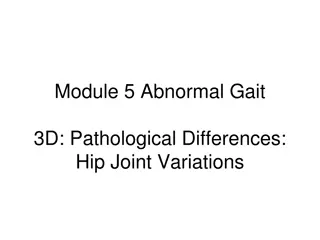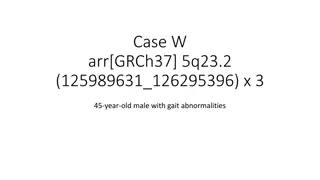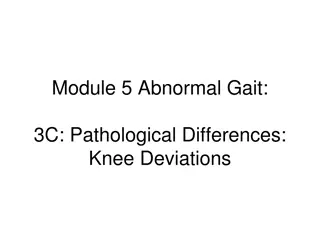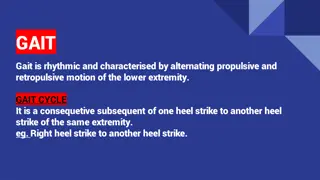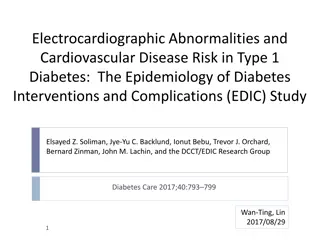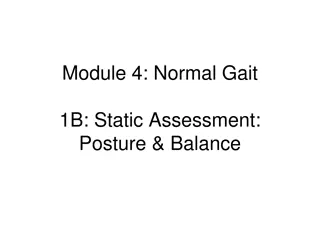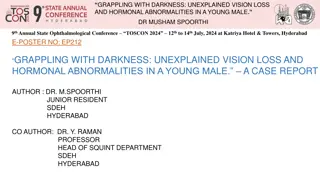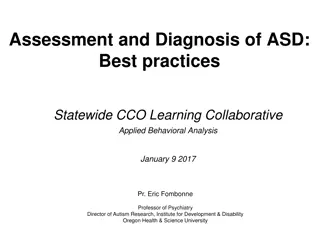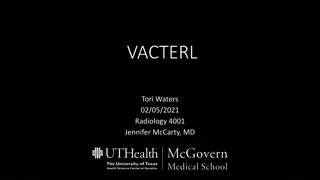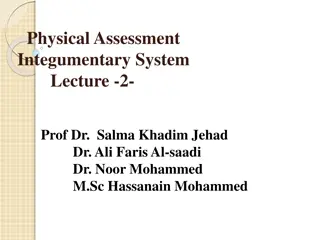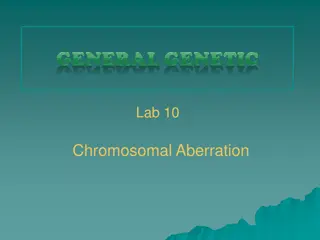Understanding Gait Abnormalities and Re-Education: A Comprehensive Analysis by Sally Kennedy
Sally Kennedy, a UK physiotherapist, explores gait abnormalities common in older individuals and those with neurological conditions. The content delves into the stages of the normal gait cycle, from initial contact to mid-swing, highlighting the importance of identifying and managing common gait problems through physiotherapy interventions.
Download Presentation

Please find below an Image/Link to download the presentation.
The content on the website is provided AS IS for your information and personal use only. It may not be sold, licensed, or shared on other websites without obtaining consent from the author. Download presentation by click this link. If you encounter any issues during the download, it is possible that the publisher has removed the file from their server.
E N D
Presentation Transcript
Movement Analysis 1 Gait abnormalities and gait re-education Sally Kennedy, UK Physiotherapist, HVO
Aims To identify the stages of the normal gait cycle To identify gait abnormalities common to older people and those with other pathology and neurological conditions Explore potential physiotherapy management of common gait problems Discussion and practical
Normal gait cycle Initial Contact Loading Response Stance Stance Swing Mid Terminal Pre Initial Mid Swing Swing Terminal Swing
Initial Contact foot touches floor usually lateral border of heel hip flexed knee extended ankle dorsiflexed to neutral
Loading Response double stance period body weight transferred forward onto stance foot shock absorption continues until other foot is lifted for swing phase
Mid Stance single limb support body weight aligned over supporting leg ankle dorsiflexed hip + knee extended
Terminal Stance heel raises from floor body weight progresses beyond the foot hip extends further
Pre Swing 2nd double stance period ankle DF knee flexion and hip extension weight transfers to opposite leg
Initial Swing foot is lifted from floor leg is advanced by hip + knee flexion ankle partially DF s to ensure ground clearance
Mid Swing tibia of swinging limb is vertical knee extends in response to gravity ankle DF s to neutral opposite leg is in mid stance
Terminal Swing begins when tibia is vertical + ends when foot touches floor deceleration of swinging limb hip maintains flexion and ankle remains DF to neutral
Horizontal Plane pelvis rotates around vertical axis ? axis = opposite hip or central spine ? pelvis moves forwards over the stationary foot static stance hip is med rotated relative to mobile pelvis
Coronal Plane pelvis drops to the swinging side hip + knee flexors + ankle DF s activate to clear ground hip ABductors + peroneii stabilise pelvis against ground reaction force and gravity
Common terminology antalgic limp adopted to avoid pain, often short stance phase on affected side ataxic unsteady, uncoordinated, often wide BOS cadence rhythmic pattern, usually even stride length, step height reciprocal putting one foot in front of the other, usually with a matching or complimentary UL pattern
Normal Changes in Older People Normal ageing means muscle bulk, strength, flexibility, loss of hearing and vision. Gait changes may include: velocity step / stride length arm swing pelvic rotation flatter foot on heel strike and push off
Osteoarthritis or Hip Surgery Trendelenburg gait characterised by: weak hip abductors limp - stance phase on affected side weight bearing on the affected side
Parkinsons Disease FESTINATING GAIT - characterised by: stooped posture hip / knee / trunk flexion trunk rotation and arm swing step length / height heel strike (initial contact) difficulty initiating / changing movement, freezing
Common compensations / gait abnormalities hip hitching or vaulting circumduction increased hip + knee flexion uneven heel rise foot slap or high stepping abducted gait increased lateral trunk sway to stance side
Practical See if you can demonstrate different gait abnormalities Speculate as to why these abnormalities may come about Try walking with different footwear and bare feet and observe the differences Any Questions?


